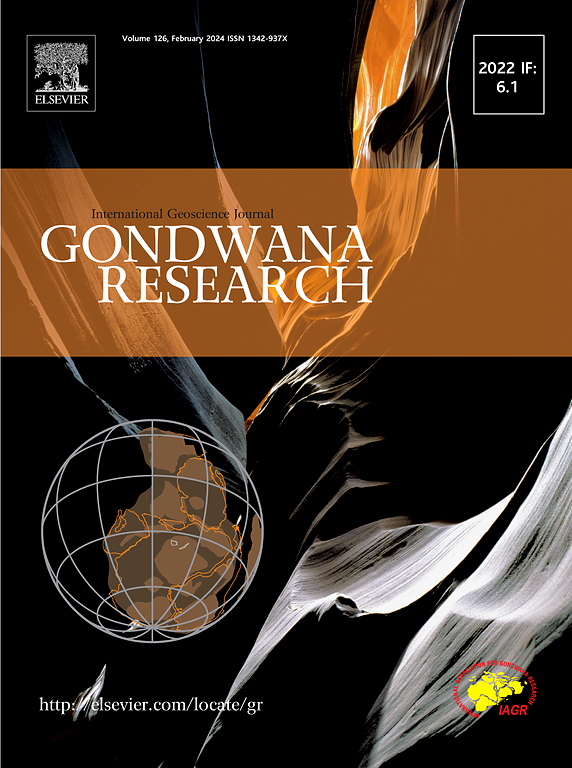萨巴尔马蒂河流域极端气候特征的空间变异:过去与未来
IF 7.2
1区 地球科学
Q1 GEOSCIENCES, MULTIDISCIPLINARY
引用次数: 0
摘要
气候变化显著影响全球和区域水文动态,从而改变极端气候。通过综合分析,揭示了印度主要西流萨巴尔马蒂河流域(SRB)在气候逐渐变暖的背景下,极端气候空间变异的变化规律。利用基线和未来数据集,开发了评估半干旱、缺水和人口稠密地区极端气候联合变率和时间演变的方法框架。本文分析了耦合模式比对项目(CMIP5) 5个大气环流模式(GCMs)在两种代表性浓度路径(RCP)情景下对SRB的统计降尺度气候预估。该研究使用多模式平均集合方法,对参考基线(1951-2019)期间的预估(2020-2100)变化进行了稳健的统计分析。利用非参数核密度估计和Mann-Whitney检验评估了极端气候的分布变化。利用相关分析和主成分分析研究了降雨和温度指数的个别和联合变率。结果表明,未来SRB气候将更加湿润和温暖,热浪、山洪和干旱等极端事件的频率和强度将增加。此外,热浪可能会加剧,而寒潮将在21世纪末消退。与RCP4.5和基线期相比,在较高的人为变暖水平(即RCP8.5)下,SRB的降雨量和极端温度之间存在很强的依赖性,表明在遥远的未来全球变暖的迹象。研究结果表明,需要立即采取有效的政策行动来减少气候变化对流域可持续发展的影响。本文章由计算机程序翻译,如有差异,请以英文原文为准。

Changes in the spatial variability of extreme climate characteristics across the Sabarmati River basin: Past and future
Climate change significantly impacts the global and regional hydrological dynamics, consequently altering the climate extremes. Through a comprehensive analysis, this study presents how the spatial variability of climate extremes is changing in major west-flowing Sabarmati River basin (SRB) in India, due to a gradually warming climate. A methodological framework to assess joint variability and temporal evolution of climate extremes for a semi-arid, water-scarce, and densely populated region, using baseline and future datasets is developed. Here, the statistically downscaled climate projections of five general circulation models (GCMs) of the coupled model intercomparison project (CMIP5) under two representative concentration pathway (RCP) scenarios are analyzed for the SRB. The study performs robust statistical analyses to assess the projected (2020–2100) changes with reference to the baseline (1951–2019) period using a multi-model mean ensemble approach. The distributional changes in climate extremes are evaluated using non-parametric kernel density estimates and the Mann-Whitney test. The individual and joint variability of rainfall and temperature indices is investigated using correlation and principal component analysis. The results show that the SRB will experience a wetter and warmer climate in the future, with increased frequency and intensity of extreme events such as heat waves, flash floods, and droughts. Further, the heat waves may likely intensify, while the cold waves would subside by the end of 21st century. A strong dependency between the rainfall and temperature extremes is detected in the SRB under higher levels of anthropogenic warming (i.e., RCP8.5) compared to the RCP4.5 and baseline period, indicating a sign of global warming in the far future. The results urge the need for immediate and effective policy actions to reduce climate change impacts for sustainable development in the basin.
求助全文
通过发布文献求助,成功后即可免费获取论文全文。
去求助
来源期刊

Gondwana Research
地学-地球科学综合
CiteScore
12.90
自引率
6.60%
发文量
298
审稿时长
65 days
期刊介绍:
Gondwana Research (GR) is an International Journal aimed to promote high quality research publications on all topics related to solid Earth, particularly with reference to the origin and evolution of continents, continental assemblies and their resources. GR is an "all earth science" journal with no restrictions on geological time, terrane or theme and covers a wide spectrum of topics in geosciences such as geology, geomorphology, palaeontology, structure, petrology, geochemistry, stable isotopes, geochronology, economic geology, exploration geology, engineering geology, geophysics, and environmental geology among other themes, and provides an appropriate forum to integrate studies from different disciplines and different terrains. In addition to regular articles and thematic issues, the journal invites high profile state-of-the-art reviews on thrust area topics for its column, ''GR FOCUS''. Focus articles include short biographies and photographs of the authors. Short articles (within ten printed pages) for rapid publication reporting important discoveries or innovative models of global interest will be considered under the category ''GR LETTERS''.
 求助内容:
求助内容: 应助结果提醒方式:
应助结果提醒方式:


